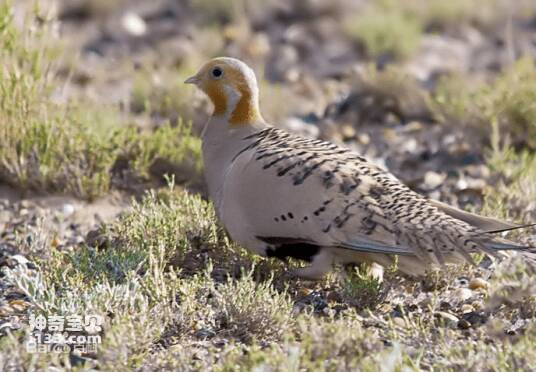Syrrhaptes paradoxus
IUCN
LCBasic Information
Scientific classification
- name:Syrrhaptes paradoxus
- Scientific Name:Syrrhaptes paradoxus,Pallas's Sandgrouse
- Outline:Landfowl
- Family:Pigeoniformes Psammophyllidae
Vital signs
- length:26.5-43CM
- Weight:182-285g
- lifetime:No textual research information is available
Feature
About the size of a pigeon, the whole body is mostly sandy gray, and the back is densely covered with black stripes
Distribution and Habitat
World distribution: China, Iran, Kazakhstan, Kyrgyzstan, Mongolia, Russia, Tajikistan, Turkmenistan, Uzbekistan.
Travellers: Austria, Belarus, Belgium, Bosnia and Herzegovina, Bulgaria, Croatia, Czech Republic, Denmark, Finland, France, Germany, Greece, Hungary, India, Ireland, Italy, Japan, Korea, Latvia, Norway, Poland, Netherlands, Montenegro, Romania, Serbia, Slovakia, Slovenia, Spain, Sweden, Switzerland, United Kingdom.
Distribution in China: Inner Mongolia, Gansu, Qinghai, Xinjiang, Heilongjiang, Jilin, Liaoning, Hebei and Shandong.
Sandgrouse mainly lives in plain grassland, desert and semi-desert areas, but also in saline-alkali forest plains and sandy fields.
Appearance
The forehead, the front of the head and the side of the head are rusty yellow, the back of the head and the back of the neck are brownish gray, the side of the neck is gray, and the sides of the base of the back neck are rusty red. The upper body is sandy brown with black stripes, among which the shoulder and back stripes are thick and thin, and the back is thinner and dense. The upper wing cover feathers and the third level of flight feathers are also sandy brown, the third level of flight feathers have blue-gray or black markings, the middle cover feathers have black circular end spots, the outer tip of the large cover feathers are chestnut, forming a chestnut cross band on the wings, the primary cover feathers are lighter brown, and the central has broad black stripes. The wing edges are sandy brown with mixed black spots, and the winglets are sandy brown outside and dark brown inside. The primary feathers are mostly blue-gray, with a black shaft. The first primary feathers are the
Details
Feather-legged sandfowl (Syrrhaptes paradoxus ) Foreign name Pallas' s Sandgrouse, no subspecies.

When a sandgrouse walks, its body swings from side to side. Flying in a wave shape forward, usually close to the ground at low altitude, and flying very fast, two wings flap very fast, and issued a whirring sound. Generally flying hundreds of meters to land, do not do long distance flight. They often move in groups, especially in autumn and winter. In the early morning and evening, groups fly to the water source to drink water, sometimes in order to find water and fly tens of kilometers. When drinking, put your mouth into the water and swallow continuously without looking up. Don't migrate, but wander. In autumn and winter, hundreds or even tens of thousands of animals wander irregularly outside the breeding area. Mainly to a variety of wild plant seeds, berries, buds, shoots, young leaves and other plant food for food.
The breeding period is from April to July. The nest is usually built on open ground or under a bush, and sometimes under grass. They often breed in pairs or small groups together, with nest spacing of 4-6 meters. The nest is very simple, mainly a pit in the ground, without any inner cushion, and sometimes a few grass stems. Two to four eggs are laid per litter, usually three. The egg is gray or earthy yellow, with brown or gray spots, and the size of the egg is 39.47 mm ×27.35 mm. Incubation usually begins after the first egg is laid, which is borne by male and female birds in turn, and the incubation period is 22-27 days.
The wool-legged sandgrouse is listed on the 2012 IUCN Red List of Threatened Species ver 3.1 - Not Threatened (LC).
The shaggy leg sandgrouse has been included in the List of Beneficial Land Wildlife under State Protection or of Important economic and scientific research Value issued by the State Forestry Administration of China on August 1, 2000.
Protect wild animals and eliminate wild meat.
Maintaining ecological balance is everyone's responsibility!








